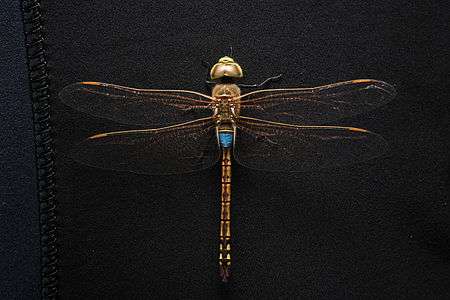Anax ephippiger
The vagrant emperor,[3] Anax ephippiger,[4] is a species of dragonfly in the family Aeshnidae. It migrates to Afro-tropical, Europe, central and southern Asia through monsoon winds.[1]
| Vagrant emperor | |
|---|---|
 | |
| Scientific classification | |
| Kingdom: | |
| Phylum: | |
| Class: | |
| Order: | |
| Family: | |
| Genus: | |
| Species: | A. ephippiger |
| Binomial name | |
| Anax ephippiger (Burmeister, 1839) | |
| Synonyms | |
Distribution
It is found in Algeria, Angola, Botswana, Cameroon, Chad, the Democratic Republic of the Congo, Ivory Coast, Egypt, Equatorial Guinea, Ethiopia, Gambia, Ghana, Kenya, Madagascar, Malawi, Mauritania, Mauritius, Morocco, Mozambique, Namibia, Niger, Nigeria, São Tomé and Príncipe, Senegal, Seychelles, Somalia, South Africa, Sri Lanka, India, Sudan, Tanzania, Togo, Uganda, Zambia, Zimbabwe, and possibly Burundi. Recorded in Malta in 1957, and every few years since, it is seen through migration in large numbers. It has never been recorded breeding in the Maltese archipelago.[5][6]
Description and habitat
It is a large dragonfly with greenish-yellow eyes. Its thorax is olivaceous-brown, paler on sides. Wings are transparent with an amber-yellow patch. Abdomen is ochreous, marked with azure-blue and reddish-brown. Segment 2 is blue on dorsum and pale green on the sides. Segments 3 to 7 are olivaceous-yellow with irregular reddish-brown stripes on mid-dorsum and narrow black apical annules. There is a broad mid-dorsal blackish-brown stripe on segments 8 and 9, enclosing a pair of triangular yellow apical spots. Segment 10 is bright yellow, with its base and mid-dorsum broadly black. Female is similar to the male.[7]
Its natural habitats are shrub-dominated wetlands, swamps, freshwater lakes, intermittent freshwater lakes, freshwater marshes, intermittent freshwater marshes, and freshwater springs. It breeds in shallow tanks and marshes.[7]
A rare long-distance migrant to the British Isles, occasionally seen even in winter.[3]
References
- Subramanian, K.A. (2016). "Anax ephippiger". IUCN Red List of Threatened Species. 2016: e.T59811A72310087.CS1 maint: uses authors parameter (link)
- "Anax ephippiger - Vagrant Emperor". British Dragonfly Society. Retrieved 28 May 2011.
- "World Odonata List". Slater Museum of Natural History. Retrieved 2018-10-02.
- Sciberras, A.; Sciberras, J.; and Magro D. (2007). A Celebration of Dragonflies. The Malta Independent. November 19, pp.8–9.
- K.A., Subramanian; K.G., Emiliyamma; R., Babu; C., Radhakrishnan; S.S., Talmale (2018). Atlas of Odonata (Insecta) of the Western Ghats, India. Zoological Survey of India. pp. 185–186. ISBN 9788181714954.
- C FC Lt. Fraser (1936). The Fauna of British India, including Ceylon and Burma, Odonata Vol. III. Red Lion Court, Fleet Street, London: Taylor and Francis. pp. 147–149.
